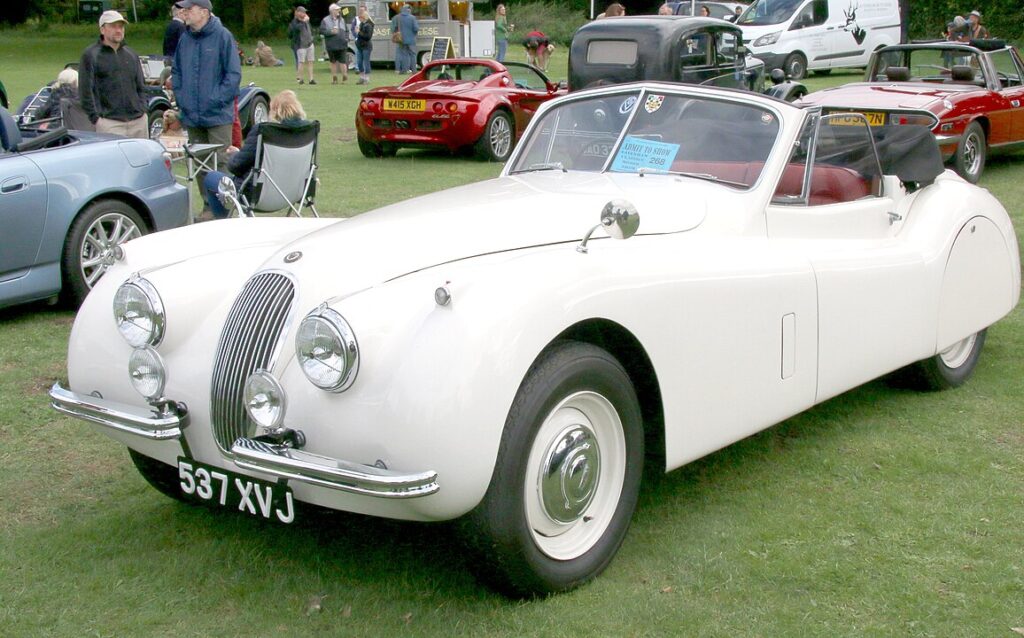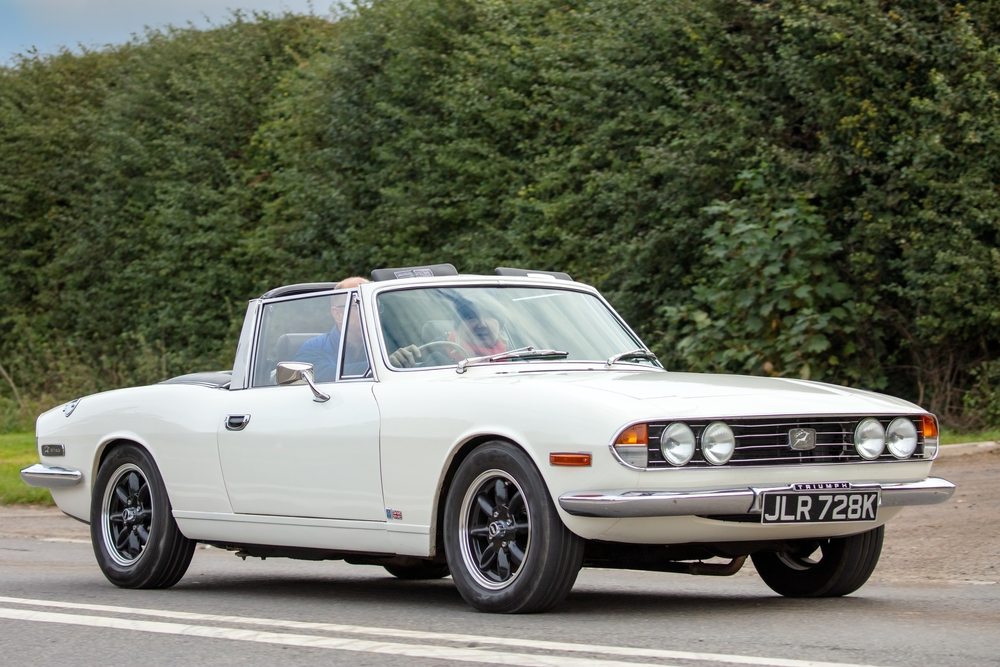Classic British sports cars have a charm all their own, combining sleek design with impressive engineering. Beyond their iconic looks, these vehicles hold unique features that set them apart from other cars of their time. Whether it’s innovative mechanics or distinctive styling details, there’s always something special under the hood. In this article, we’ll take a closer look at 18 unique features that make classic British sports cars truly unforgettable.
Contents
Wire Spoke Wheels

Wire spoke wheels are a hallmark of classic British sports cars like the Jaguar E-Type. These wheels were both lightweight and stylish, designed to improve handling by reducing unsprung weight. Their intricate design added a touch of elegance, while their durability made them a practical choice for performance. The spokes provided flexibility, which helped absorb shocks from rough roads, enhancing the car’s overall ride quality.
Wooden Dashboards

The luxurious wooden dashboards found in classic British sports cars, such as the MG TD, were a nod to craftsmanship and elegance. Made from fine woods like walnut or mahogany, these dashboards added warmth and sophistication to the cabin. The polished wood wasn’t just for looks; it was also durable and resistant to wear, giving the interior a premium feel that contrasted with the utilitarian materials used in other parts of the car.
Knock-Off Wheel Hubs

Knock-off wheel hubs, commonly seen on Aston Martins, made wheel changes faster and more convenient. Unlike traditional lug nuts, these hubs could be loosened or tightened with a single knock using a mallet. This quick-release mechanism was a practical feature during racing, where pit stops needed to be swift. Additionally, it provided a distinctive look that became synonymous with high-performance British sports cars.
Leather Bucket Seats

Leather bucket seats in cars like the Triumph TR6 offered both luxury and function. The deep, supportive design of the seats helped keep drivers secure during high-speed cornering, while the leather upholstery added a touch of class. Over time, the leather would develop a patina, giving the interior character. These seats were built for long drives, providing comfort while still maintaining a sporty feel.
Side-Exit Exhausts

Side-exit exhausts, as featured on the AC Cobra, were not just about aesthetics. Positioned on the sides of the car, they reduced back pressure and allowed the engine to breathe more freely, improving performance. This design also gave the car a unique, aggressive sound. The placement near the door added to the thrill, reminding drivers of the raw power beneath the hood.
Front-Hinged Bonnet (Hood)

The front-hinged bonnet, found on models like the Austin-Healey, was both functional and stylish. By hinging the hood at the front, it provided easier access to the engine for maintenance. This design also contributed to the car’s sleek profile, as the bonnet could be made longer, giving the vehicle its iconic stretched look. It was a practical feature wrapped in an aesthetic appeal.
Aluminum Body Panels

Aluminum body panels, such as those used on the Lotus Elite, were revolutionary for reducing weight while maintaining strength. Aluminum’s lightweight properties improved acceleration, handling, and fuel efficiency. Additionally, it resisted rust better than steel, ensuring the car’s longevity. This innovation was critical in giving British sports cars a performance edge over their heavier rivals.
Toggle Switches

Toggle switches, commonly found in older Jaguars, were a throwback to a simpler time when functionality and style went hand in hand. These switches controlled various features like lights and ignition, and their tactile, mechanical feel added to the driver’s connection with the car. The switches’ metallic finish and click response made them iconic components of British car interiors.
Rear-Wheel Drive Layout

The rear-wheel drive layout, used in cars like the Jaguar XK120, was a defining feature of classic British sports cars. This setup provided better weight distribution, enhancing handling and acceleration. Rear-wheel drive allowed drivers to experience more precise control, especially during cornering, making it the preferred choice for performance-focused cars. It remains a hallmark of many classic sports car designs.
Lucas “Prince of Darkness” Electronics

Lucas electronics, infamously dubbed the “Prince of Darkness,” became an iconic part of British car lore. While often unreliable, these electrical systems were unique to British manufacturers like Triumph and MG. Despite their quirks, Lucas systems were innovative for their time, incorporating advanced lighting and ignition technologies that became standard in the industry. Their legacy endures as part of the charm of classic British cars.
Minimalist Interiors

Minimalist interiors, such as those in the Lotus 7, emphasized performance over luxury. Stripping away unnecessary comforts allowed for a lightweight build, enhancing speed and handling. The lack of frills gave these cars a raw, driver-focused feel, making them perfect for racing and enthusiasts who valued simplicity. The bare-bones design highlighted the purity of the driving experience.
Exposed Hinges

Exposed hinges, as seen on roadsters like the Morgan Plus 4, added to the vintage aesthetic of these cars. Rather than concealing them, the hinges were left visible, enhancing the car’s hand-built, mechanical look. They became a signature design element that set these cars apart, reflecting the craftsmanship that went into each model.
Classic Smiths Gauges

Smiths gauges, featured in cars like the Jaguar XK120, were renowned for their precision and timeless design. These analog instruments provided clear, reliable readings of speed, RPM, and engine temperature. Their simple, black-and-white aesthetic made them easy to read while adding a touch of class to the dashboard. They’re still admired today for their craftsmanship.
Overdrive Switch

The overdrive switch, found in cars like the Triumph Stag, was an innovative feature that allowed for smoother high-speed cruising. By activating the overdrive, drivers could reduce engine RPMs at higher speeds, improving fuel efficiency and reducing engine wear. This extra gear was a clever solution to the limited gear ranges of early sports cars, offering both performance and practicality.
Double Wishbone Suspension

Double wishbone suspension systems, as seen in the Lotus Elan, were favored for their precision and stability. This setup allowed for independent control of each wheel’s movement, providing superior handling and a smoother ride. The design reduced body roll during cornering, making these cars more agile and responsive, key traits for a sports car.
Rear Spare Tire Mounts

The rear spare tire mounts, often found on Austin-Healey models, provided a convenient and stylish solution for carrying a spare. Mounted on the trunk or rear bumper, these tires were easily accessible and added to the car’s rugged, road-ready appearance. This feature became a staple of British roadsters, reflecting their practical design for long-distance touring.
Classic Grilles

The classic grilles of cars like the Aston Martin DB5 became iconic symbols of British automotive design. These grilles were more than just aesthetic; they allowed air to cool the engine while giving the front of the car a distinctive, aggressive look. Each brand had its own unique grille design, often instantly recognizable and contributing to the car’s identity.
Hand-Built Bodies

Many British sports cars, like the Morgan 4/4, were hand-built, which gave them a unique, artisanal quality. The hand-crafted nature of these cars meant that no two were exactly alike, adding to their exclusivity. This level of craftsmanship ensured that every car was made with attention to detail, resulting in vehicles that were not just machines but works of art.
This article originally appeared in MyCarMakesNoise.
More from MyCarMakesNoise
25 Groundbreaking EVs That Revolutionized Sustainable Driving

Electric vehicles (EVs) have revolutionized the way we think about transportation, offering a greener alternative to traditional gas-powered cars. In this article, we explore 25 EVs that have paved the way for sustainable driving. Read More
20 High-Speed Trains Revolutionizing Global Transit

Discover the world’s fastest trains that redefine travel as we know it. From cutting-edge technology to breathtaking speeds, these marvels of engineering are revolutionizing transportation. Read More
20 Must-See Luxury Yachts for the Ultimate Seafaring Journey

Embarking on a seafaring adventure aboard a luxury yacht is the epitome of elegance and relaxation. Whether you’re seeking serene ocean escapes or thrilling voyages, these top 20 luxury yachts offer unparalleled comfort, cutting-edge design, and world-class amenities. Read More














